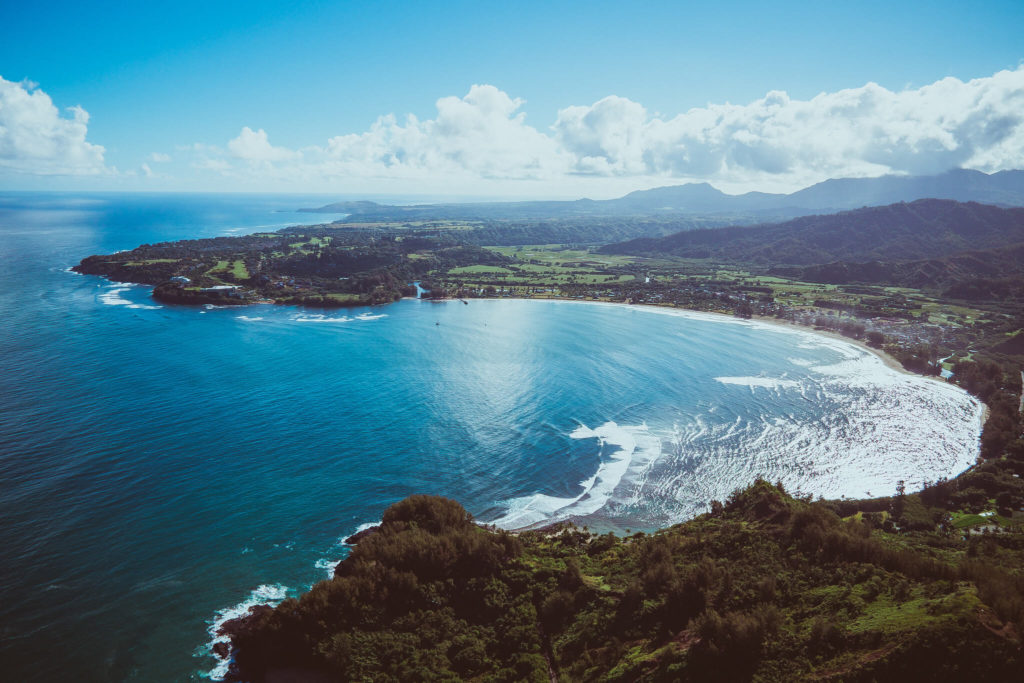The Hanalei Bay is a 2 mile long stretch of white sand and home to a breathtaking mountainous backdrop. This is not only regarded as the best beach on the North Shore but is also the largest bay on the island of Kauai. It is no wonder that tourists flock to this part of the island to experience everything it has to offer. Hanalei Bay is also featured in our list of top 10 must-do outdoor adventures in Kauai.
The right side of the bay has a large reef which gives rise to large waves that fulfill every surfing enthusiast’s desire. At different sections, the beach has waves of varying intensities. The calm and shallow waters near the bay are suitable for beginners. As we progress to the middle of the bay, the waves get more playful and are well suited for bodyboarding and beginner surfers.
This crescent shaped bay is full of white sand and consists of four separate beaches within it. These can be regarded as four zones with each one offering a different experience. The Waikoko beach is situated on the western side of the bay and the Black Pot beach can be found on the eastern end, near the Hanalei Pier. The Hanalei beach Park and Wai’oli beach park are found in between.
In spite of being the largest bay on the island, Hanalei bay is rarely crowded and offers plenty of room to do your own thing. During summer, the bay is placid and offers excellent conditions for mooring of sailboats, paddleboarding and swimming.
Let us briefly touch upon the individual beaches along the Hanalei bay:
Black pot beach – The name of the beach is quite old and is so because the beach used to have a big black pot which was used to cook fish during celebrations. The locals flock to this part of the beach for picnics and camping as camping permits are provided on weekends. This is where the Hanalei river stream joins the bay and serves as the originating point for kayakers wishing to kayak through the Hanalei river. Swimming here is not the best of ideas as the place is close to the river and the water can get muddy.
Waikoko beach – This serves as a nice picnic spot as it has lot of shade and is never crowded. The waters here are shallow and filled with many small erratic waves which is part of the reason why people don’t prefer swimming here. However, it can be a good place for children to play. The Waikoko beach can be accessed from the highway but needs you to climb down an embankment. This area also has a protected reef and is good for snorkelling.
Hanalei beach – It forms the heart of Hanalei Bay. Located along a 2-mile stretch, the varying water conditions along the beach cater to all kinds of people. The waters are especially calm near the Hanalei pier. The pier base is home to a lot of fish which cannot be found on the other parts of the beach. Walkers and joggers can often be seen along the hanalei bay pavillion as there is no end to activity on this part of the bay. The beach has a lifeguard tower and is pretty safe for children, especially during the calm summer months.
Wai’oli beach – It is located on the middle of the crescent shaped bay. A part of this beach is also called “PineTrees” as it consists of a lining of pine and ironwood trees. This part of the bay gets large currents and this is where experienced surfers get into action. The annual surfing contest is conducted here and It is a treat to watch surfers of all levels display their skills.
Hanalei Bay Weather
The average annual temperature in the region is about 24 degree celsius. The hottest month is September and the Coolest month is January. The region experiences the least sunshine in December and is mostly cloudy during this time. If you have sunbathing plans on the beach, then April would be the ideal month for you as it gets the highest sunshine.
Anytime between April and September should be a good time to visit Hanalei Bay. If your visit is solely based on surfing, then October through May should be an ideal time for you.
The North shore experiences a water swell during the winter months and has high surf during this time of the year. Hanalei Bay gets strong winds and water currents during these months and it is not surprising to see the high surfs go upto 20 m in height. The winter winds can make the waters rough and cause shorebreaks. Rainfall can cause the Hanalei stream to make the waters muddy which is not favourable towards people getting into the water.
As a word of caution, be prepared for the rains as it can rain any time of the year on this part of the island.
Hanalei Pier
This is the main attraction in Hanalei and is an ideal spot for savouring a panoramic view of the bay, beach houses, surfers and the mountains without getting your feet wet. If you look closely towards the mountains, you might even spot some waterfalls. However, the clouds may obstruct the view of the mountains on a cloudy day.
Over the years, the pier has seen several facelifts. The pier has recently been covered with canopy through a combined effort of locals and the rotary club. It’s a common sight to see children jumping of the pier into the water, as this part of the beach is usually calm. The pier can be overly crowded sometimes, but this should not bother you from enjoying the beautiful sunset with your loved ones.
Where to park?
It is best that you drive to the end of the road near the river, at the Black Pot Beach. This place is close to the Hanalei Pier. From there, you can walk down the entire stretch of the beach exploring all the sections along the way.
In Conclusion
The largest bay on the island surely has a lot to offer. Enthralling visitors with its picturesque backdrop, scenic spots, playful beaches and great resorts and restaurants nearby, Hanalei Bay is one of its kind. This crown jewel of the north shore will definitely leave you with rich memories and an ever increasing desire to revisit the place.




